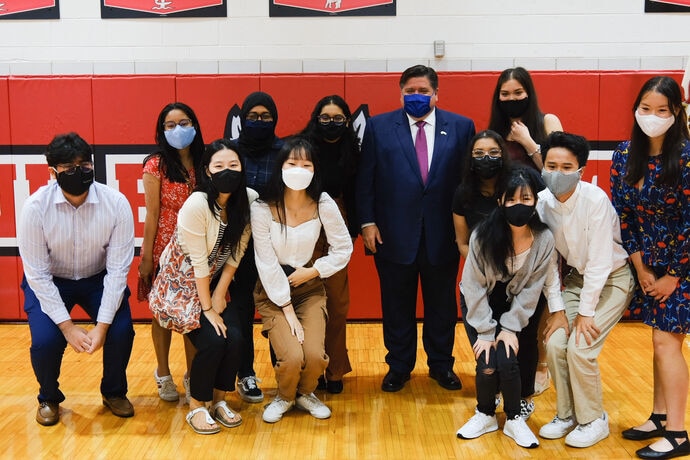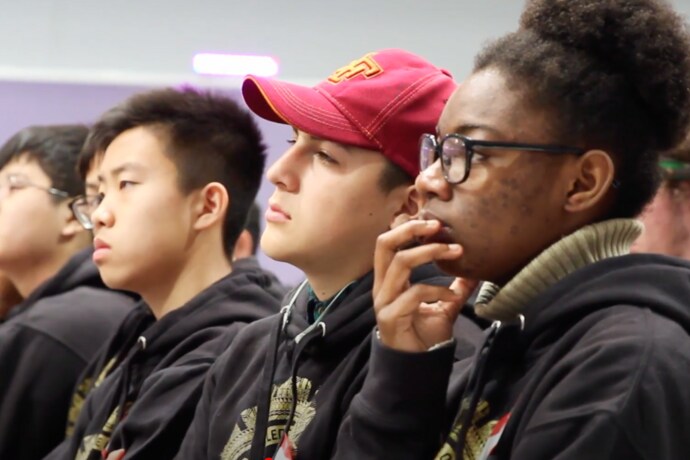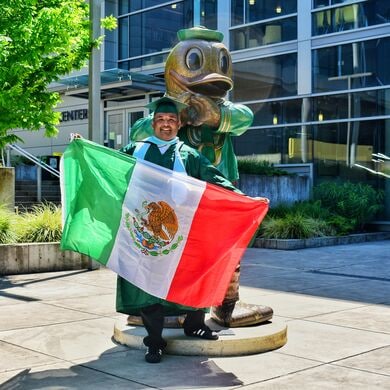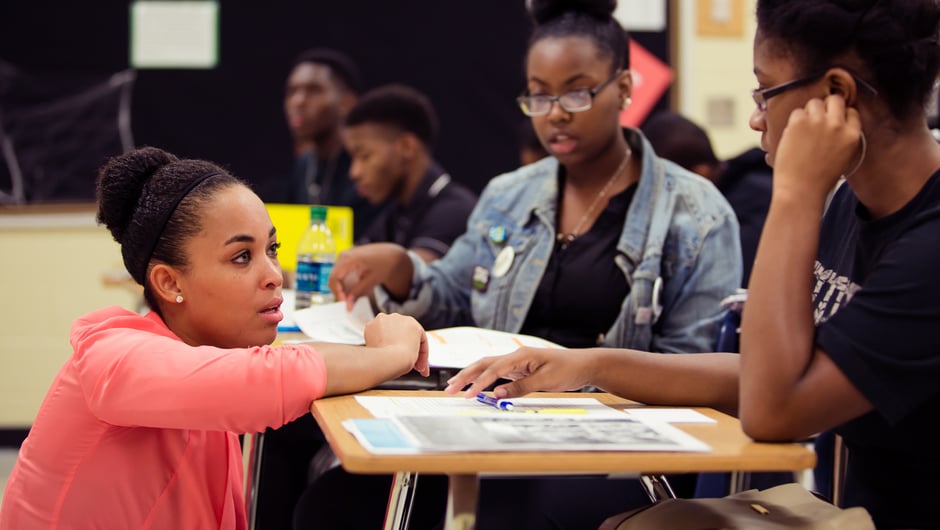
How Schools Are Building a More Inclusive Curriculum
A movement to expand ethnic studies in schools seeks to center the diverse perspectives and stories of marginalized groups historically excluded from K-12 curricula.
Last summer, 16-year-old Kirsten Ng filed into Niles West High School in Skokie, Illinois, and watched Governor J.B. Pritzker sign the historic Teaching Equitable Asian American Community History (TEAACH) Act, which requires the teaching of Asian American history units in Illinois public schools.
For months before that, Ng and other high schoolers in Illinois had been raising awareness of the TEAACH Act. They collected signatures for the bill, phoned their local representatives, and hosted teach-ins with fellow students to highlight the merits of teaching Asian American history in schools.
“My goal for this bill was to ensure that other Asian American children wouldn’t have to go through what I did and independently research their history,” Ng says. “I hope that my 5-year-old cousin can learn about her history in school.”

A Varied Landscape for Ethnic Studies in Schools
The law is far from the only recent effort to incorporate ethnic studies into curricula across the United States.
Even as several states seek to restrict the teaching of culturally relevant lessons and a full examination of racism in America, dozens are moving to expand the curricula in K-12 schools to include comprehensive lessons about historically marginalized groups. In October 2021, California became the first state to require all public school students to complete an ethnic studies course to graduate.
Today, ethnic studies programs vary by state and district, ranging from individual units on underrepresented groups to year-long courses that focus on particular groups and their history. The content can include new courses like Black studies, Latinx studies, Asian American history, and Native American studies.
All students benefit from learning a full and accurate accounting of history and about diverse groups and perspectives. But these courses are especially crucial for students in historically marginalized groups. For Black and Indigenous students and other students of color, a lack of representation—and misrepresentation—in curricula and lessons can be hurtful and even traumatic, and make learning much more challenging.
Research shows that ethnic studies courses help address these painful inequities while also having wide-ranging positive impacts on all students. Studies indicate that culturally relevant courses and programs increase academic engagement, improve test scores and attendance rates, and close the opportunity gap.
“The job of a teacher is to affirm their students, their identities, and who they are; that’s the best way to teach students and help kids grow,” said Ellen Zhou, an education activist in Illinois who believes students of color benefit from expanded access to their history. “It also makes students much more connected to what they’re learning.”
Pathbreaking Programs in California
California's recent move to require ethnic studies courses for all public school students was the result of decades of advocacy, first led by college students. In the 1960s, San Francisco led the way for the ethnic studies movement in the United States, establishing the country’s first College of Ethnic Studies at San Francisco State University and the first ethnic studies department at the University of California, Berkeley.
“It started when university students and community members in [places like California] got frustrated with the lack of relevance of university education in addressing the issues in communities of color,” said Christine Sleeter, co-author of Transformative Ethnic Studies in Schools: Curriculum, Pedagogy, and Research. “Activists demanded that universities start offering courses taught by people who were knowledgeable about historically marginalized and racialized communities.”
“I hope that my 5-year-old cousin can learn about her history in school.”
San Francisco remains at the forefront of K-12 ethnic studies education to this day. The San Francisco Unified School District (SFUSD) first launched an ethnic studies program in February 2010 for incoming ninth-graders with a GPA below 2.0. With this pilot program, the city hoped to bridge the achievement gap and increase graduation rates, while decreasing truancy, high school dropout rates, and incarceration rates among students.
The academic outcomes of the pilot program were positive.
Students at risk of academic withdrawal saw a significant increase in their graduation rates, with many students more likely to enroll in college. Compared to students who did not participate in the program, students earned up to six more class credits. In light of this, the district expanded ethnic studies as an elective across all public high schools in 2014. The curriculum covers a broad range of often overlooked historical topics, from the Native American genocide in California to Filipino American and Black farmworker labor organizing during World War II, and current issues.

Courtesy of San Francisco Unified School District
“My ethnic studies class focuses on current events from mass incarceration to systems of power,” said San Francisco ethnic studies teacher Reynaldo Dulaney. “Students are responsive to the curriculum.”
Today, around 85% of San Francisco’s public school students are students of color. A joint Stanford-San Francisco 2021 study found that ethnic studies in San Francisco public schools increased high school graduation rates, college enrollment, and the number of credits earned by high school students, all while decreasing absenteeism in the classroom. Propelled by these findings, in March 2021, San Francisco made taking ethnic studies a graduation requirement for all public high schools beginning with the class of 2028.
“We want students throughout our course to better love who they are and where they come from, and be in solidarity and connection with others,” said Nikhil Laud, the ethnic studies coordinator for the San Francisco Unified School District. “In doing so, they can have the ability to change their society and community for the better.”
How Mexican American Studies Is Impacting Texas Students
Many students in Texas have been empowered in similar ways, thanks to an ethnic studies movement there.
Nearly 40% of the population of Texas is Latinx, and the vast majority are of Mexican descent. In 2018, after years of advocacy work and contentious debate, the Texas State Board of Education approved a standardized K-12 Mexican American Studies course. The approved course teaches students across Texas about topics ranging from the founding of Mexico to the history and cultural contributions of Mexican Americans.
“The job of a teacher is to affirm their students, their identities, and who they are; that’s the best way to teach students and help kids grow.”
Before the state board of education’s decision, some schools in Texas had already created Mexican studies classes. One of those schools, Donna High School, has a thriving Mexican American studies program that uses community-based projects to shed light on the local history of people of Mexican descent and empower students by showing them how historical knowledge is created.
A project about the Alamo Train Crash of 1940 is one example. That accident was one of the worst highway collisions of the 20th century in Texas, resulting in the deaths of more than 30 Mexican farmworkers when a train hit their truck. The fatalities included farmworkers as young as 10 and illuminated the precarious transportation conditions of agricultural workers.
When Mexican American studies teacher Juan Carmona learned that the town of Alamo, Texas—just 10 minutes from Donna High School—was erecting a historical marker to commemorate the incident, he enlisted his students to produce a four-episode podcast excavating the larger story of Mexican farmworkers in Texas. His class pored through archival news clippings describing the train crash and even interviewed the truck driver’s surviving family. Students like Taylor Seaver, 18, herself the daughter of a Mexican farmworker, narrated the podcast. “Instead of learning what’s in the book, [students are] going out and creating more history, preserving information, and researching things that people haven’t researched,” said Juan Carmona. “They start to understand that education is a very political thing.”
It makes sense to teach Mexican American studies in the state—and throughout the U.S., according to Christopher Carmona, Ph.D., a Mexican American studies professor at the University of Texas at Rio Grande Valley who has fought for standardized Mexican American studies courses to be taught in K-12 classrooms. “Mexican American history is American history. More than half of this country was originally Mexico,” he said. “One of the things that's important to teach is that Mexican Americans were an integral part of this country from the get-go.”
Moreover, there are now 1.4 million more Latinx students than white students attending the state’s public schools, making the state’s ability to provide relevant educational content to this population increasingly important. Another way Juan Carmona achieves this is by incorporating oral history projects into lesson plans, which allow students to interview their own family members.
For example, when Seaver, the student narrating the four-part podcast on the Alamo Train Crash, interviewed her own family members about their experiences as seasonal farmworkers, she discovered how horrendous the housing conditions and transportation methods were. Seaver described her grandmother and mother being penned in trucks and living next to animals on ranches. “They were basically animals to the predominantly white ranch owners,” Seaver said. Seaver’s grandmother also recounted how she had once gone to the general store with hands stained from picking berries. “One of the cashiers said, ‘We’re not going to accept your money, because your hands are dirty—you’re a fruit picker,’” Seaver recalled. By conducting these oral histories, some students emerged with deeper links to their own families, Juan Carmona noted. Students gained an appreciation for the importance of preserving memories and placing events in the context of class, race, and ethnicity.
Research shows that Mexican American studies classes and other ethnic studies courses sharpen critical thinking skills and improve academic engagement because students identify more with the academic material. The classes can also shape how students look at the discipline of history.
In some cases, it may even inspire them to teach it. Today, Seaver is studying to be a history teacher at a nearby college. “[The classes] taught me that if I can make engaging lessons that students relate to, they’re going to feel more heard and want to participate more,” she said.
Like Seaver, Jesus Narvaez Santiago was inspired to become a teacher by ethnic studies classes he took as a student. Born in Tepic, Mexico, Narvaez Santiago was a recipient of the Deferred Action for Childhood Arrivals (DACA) program, and often “felt out of place” in his Oregon high school as an undocumented immigrant. But he also took classes at the Puertas Abiertas Leadership Academy, an enrichment program in Eugene, Oregon, for Latinx students. Those courses catalyzed him to later study ethnic studies at the University of Oregon.
“It was a space of empowerment,” Narvaez Santiago said about Puertas Abiertas, which ultimately upended his worldview on education. At Puertas Abiertas, teacher Jim García framed learning history from multiple perspectives, exploding the myth of a single, stock story and helping students recognize the value of their own stories.
During a class assignment at Puertas Abiertas, García asked students like Narvaez Santiago to reflect on the origins of their names and explain their lineage. “It was scary to talk about it; we don’t talk about our family history or the fact we come from Indigenous blood,” Narvaez Santiago remembered. He only learned he was part of Mexico’s Indigenous Cora ethnic group as a result of the assignment. During the process of interviewing family members, Narvaez Santiago was devastated to learn that his grandmother had lost her native language—a fact he may never have discovered if not for the class project. “That was sad to find out—my grandparents don’t talk about it anymore,” he said.
“Our curriculum stays with them for the rest of their lives,” said García, who takes great pains to treat education as a discovery process. Students engage with the content so deeply that it often resets their academic trajectory. Today, Narvaez Santiago teaches high school ethnic studies in Oregon, which allows him to talk about Indigenous communities to young high schoolers.

Putting an End to Excluded History Lessons
Other states are also engaged in expanding culturally relevant curricula and broadening the lens through which history is taught, be it through implementing ethnic studies courses or units or expanding curriculum requirements.
Native American students, who constitute approximately 1% of students nationwide, rarely receive instruction on their history or culture in schools. A 2019 survey found that only 11 states with large Native American populations have a requirement to include the stories of Native Americans in their curriculum.
That’s changing in some states with a large number of Native American tribes, such as:
- Oregon: In 2017, Oregon passed the Tribal History/Shared History bill, providing funding to nine federally recognized tribes to design their own place-based curriculum—learning that is rooted in a student’s local history, culture, and environment—and mandating a K-12 Native American curriculum statewide.
- North Dakota: Approximately 10% of students are Native American in North Dakota, where a 2021 law requires schools to teach Native American history. Prior to this law, teaching Native American history was left to each district’s discretion.
- Minnesota: Over the next two years, the Minnesota Department of Education is mobilizing $1.3 million for Native American education, including developing curricular resources on Native American history and hiring two full-time staff members solely focused on implementing Native American education standards.
There are also efforts to expand Indigenous studies in several other states. For example, in Connecticut—which became the first state to require all high schools to offer courses on Black and Latinx studies in 2020—schools will be required to teach Native American studies in social studies curricula starting the 2023-2024 school year.
“We want students throughout our course to better love who they are and where they come from, and be in solidarity and connection with others.”
But there remains much work to be done to include more culturally relevant and accurate lessons about Native Americans in schools nationwide. A study done in 2019 by the Reclaiming Truth Project, the country’s largest research initiative led by Native Americans, found that 27 states did not name a single Native American in their K-12 curriculum. The study showed an even more dire situation for contemporary Native American history. It found that 87% of states failed to even mention Native American history after 1900, allowing some of the biggest issues facing Native Americans today—invisibility and pernicious myths and stereotyping—to persist.
How Black history is taught is also being reexamined as the nation reckons with its long history of systemic racism. One big issue is that Black history lessons are often rooted in or limited to slavery, instead of including discussions about African civilizations that predate the trans-Atlantic slave trade. These lessons fail to provide an accurate picture of how many African kingdoms flourished before the period of slavery.
And even Black history lessons that are rooted in slavery often do not accurately capture the narratives, experiences, and humanity of enslaved people and instead center the narratives of white people. A 2017 report by the Southern Poverty Law Center that reviewed 10 popular U.S. history textbooks found that the majority of these textbooks do not adequately cover the history of American slavery. The textbooks also fail to sufficiently delve into—or even ignore, in some instances—the legacy of slavery, including Jim Crow and racist housing policies and the many ways systemic racism impacts the Black community today. All of this amounts to a whitewashing and erasure of Black history in America.
But calls for a comprehensive, accurate, and culturally responsive accounting of Black history are growing in many states, including states where some politicians seek to restrict the teaching of racism in America. In 2021, Florida implemented a statute requiring students to learn Black history—including African history before slavery—and about the contributions of Black Americans to the country. A 2021 New Mexico law known as the Black Education Act not only mandates a culturally inclusive curriculum that re-examines Black culture and history, but introduces anti-racism training for teachers and a hotline for reporting racial bias in public schools. And in Delaware, Governor John Carney signed legislation this year requiring Black history to be part of all aspects of education, with a focus on Black contributions to all facets of American life, politics, and culture.
Obstacles to Implementing Ethnic Studies in K-12 Schools
Efforts to expand culturally relevant and historically accurate curricula have not been without opposition. There have been roadblocks, including legislation in several states in recent years designed to restrict discussions of racism.
“Whenever you have major social shifts, there’s a backlash of bills which try to stop the tide of change—it comes through in violence or legislative efforts that fail,” Christopher Carmona said. “The [ethnic studies] waves have already hit; it’s already happening, it’s too late.”
Another challenge in the ethnic studies movement comes from the lack of consensus around what ethnic studies is and how educators should teach those subjects. In particular, there is debate about whether ethnic studies should function as standalone lessons or be fully integrated into history classes.
In a 2020 Washington Post opinion piece, University of Pennsylvania history education professor and author Jonathan Zimmerman argued relegating ethnic studies to separate courses, as opposed to incorporating the experiences and perspectives of people of color into “standard” history courses, can potentially do more harm than good. “No single class can teach students about our country’s irreducible diversity. It might even make things worse, by letting the rest of the curriculum off the hook,” Zimmerman wrote.
Experts say there are proven ways for teachers to incorporate ethnic studies throughout their classroom content. It’s possible for teachers at the local and district level to create ethnic studies consortium groups to develop plans to do that work, says Andrew J. Jolivétte, Ph.D., a professor of ethnic studies at the University of California, San Diego. “I think teachers with the necessary training in ethnic studies can add ethnic studies lessons and course content into their regular classes, and this will actually help them, in many cases, to meet state standards.”
Ethnic Studies as a Tool of Self-Discovery and Empowerment
The student activist roots of the 1960s ethnic studies movement live on today in the youth who continue to fight for accurate, inclusive, and culturally relevant curricula in K-12 schools. For these students, efforts to ensure their histories are accurately reflected in classroom content is both personal and empowering.
Like Kirsten Ng, Meghana S., a junior at Lane Tech High School in Chicago, worked with other student activists to support the TEAACH Act. Realizing the gaps in their education, Meghana and other Chicago public school student activists used the pandemic to brainstorm what it would be like to receive Asian American history in their schools and how that would change the lives of other students.
Meghana collected signatures, sent out links, and created teach-ins over Zoom to sensitize educators and peers about the Act. It was eye-opening, Meghana said, to see how much of Asian American history had never been taught, but she was gratified that the state had created the requirement: “I’m so young, I’m only 16, and I’ve already been part of creating a law that will benefit so many people.”
Sign up to receive articles like this in your inbox!
Thanks for signing up!
Content is loading...







